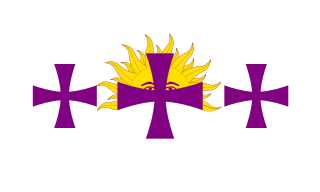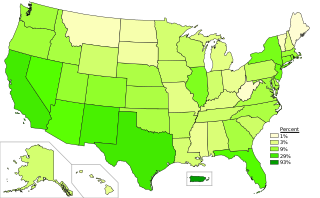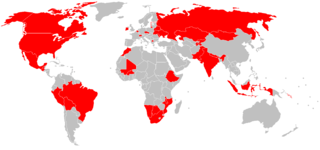
This article is about the demography of the population of Trinidad and Tobago including population density, ethnicity, education level, health of the populace, economic status, religious affiliations and other aspects of the population.

The term Hispanic refers to people, cultures, or countries related to Spain, the Spanish language, or Hispanidad broadly.

The United States does not have an official language at the federal level, but the most commonly used language is English, which is the de facto national language. In addition, 32 U.S. states out of 50 and all five U.S. territories have declared English as an official language. It is also the language spoken at home by the great majority of the U.S. population. Many other languages are also spoken at home, especially Spanish, according to the American Community Survey (ACS) of the U.S. Census Bureau; others include indigenous languages originally spoken by Native Americans, Alaska Natives, Native Hawaiians, and native populations in the U.S. unincorporated territories. Other languages were brought in by people from Europe, Africa, Asia, other parts of the Americas, and Oceania, including multiple dialects, creole languages, pidgin languages, and sign languages originating in what is now the United States. Interlingua, an international auxiliary language, was also created in the U.S.

The German diaspora consists of German people and their descendants who live outside of Germany. The term is used in particular to refer to the aspects of migration of German speakers from Central Europe to different countries around the world. This definition describes the "German" term as a sociolinguistic group as opposed to the national one since the emigrant groups came from different regions with diverse cultural practices and different varieties of German. For instance, the Alsatians and Hessians were often simply called "Germans" once they set foot in their new homelands.

Puerto Ricans are the people of Puerto Rico, the inhabitants, and citizens of the Commonwealth of Puerto Rico and their descendants.

Spanish is the second most spoken language in the United States. Over 42 million people aged five or older speak Spanish at home. Spanish is also the most learned language other than English, with about 8 million students. Estimates count up to 57 million native speakers, heritage language speakers, and second-language speakers. There is an Academy of the Spanish Language located in the United States as well.

Hispanophone refers to anything related to the Spanish language.
Latin Americans are the citizens of Latin American countries.

Venezuelan Americans are Americans who trace their heritage, or part of their heritage, to the nation of Venezuela. The word may refer to someone born in the U.S. of Venezuelan descent or to someone who has immigrated to the U.S. from Venezuela.
Hispanic and Latin American Australians refers to Australians who are of Hispanic, and/or Latin American origin irrespective of their ancestral backgrounds, and their descendants. Brazilian Australians make up the largest proportion of Hispanic and/or Latin American Australians, followed by Chilean Australians and Salvadoran Australians. Most Hispanic and Latin American Australians speak English but many continue to use Spanish or Portuguese as well.
Argentine Australians are Australian citizens of Argentine descent or birth. According to the Census there were 9,879 Australians who claimed full or partial Argentine ancestry and 20,940 Argentina-born citizens who were residing in Australia at the moment of the census.

Venezuelans are the citizens identified with the country of Venezuela. This connection may be through citizenship, descent or cultural. For most Venezuelans, many or all of these connections exist and are the source of their Venezuelan citizenship or their bond to Venezuela.

Costa Ricans are the citizens of Costa Rica, a multiethnic, Spanish-speaking nation in Central America. Costa Ricans are predominantly Castizos, other ethnic groups people of Indigenous, European, African and Asian descent.
Kenyan Australians are Australian citizens and residents of Kenyan origin and descent. They may be of indigenous African, European, or Indian heritage.
Hispanic and Latino New Mexicans are residents of the state of New Mexico who are of Hispanic or Latino ancestry. As of the 2020 U.S. Census, Hispanics and Latinos of any race were 49.3% of the state's population.

Many countries and national censuses currently enumerate or have previously enumerated their populations by languages, native language, home language, level of knowing language or a combination of these characteristics.

Malaysians are citizens who are identified with the country of Malaysia. Although citizens make up the majority of Malaysians, non-citizen residents and overseas Malaysians may also claim a Malaysian identity.

Trinidadians and Tobagonians, colloquially known as Trinis or Trinbagonians, are the people who are identified with the country of Trinidad and Tobago. The country is home to people of many different national, ethnic and religious origins. As a result, Trinidadians do not equate their nationality with race and ethnicity, but with citizenship, identification with the islands as whole, or either Trinidad or Tobago specifically. Although citizens make up the majority of Trinidadians, there is a substantial number of Trinidadian expatriates, dual citizens and descendants living worldwide, chiefly elsewhere in the Anglosphere.
The Latin American diaspora refers to the dispersion of Latin Americans out of their homelands in Latin America and the communities subsequently established by them across the world.

Venezuelan Argentines are Argentine citizens of partial or full Venezuelan descent, or Venezuelan citizens who have migrated to and settled in Argentina. As of 2022, there are 272,000 Venezuelans living in Argentina, most of whom migrated during the latter half of the 2010s as part of the Venezuelan refugee crisis. The last census held in Argentina, in 2010, registered only 6,000 Venezuelan migrants living in the country.














